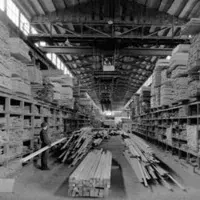A New Narrative: Primary Products at Adam Art Gallery
Written by

By Mark Amery Courtesy of The Dominion Post 5/9/07
The subject of Primary Products at the Adam Art Gallery is our relationship with our exotic forests, its timber product and its trade. Yet the exhibition also provides interesting contemplation on the industry of the art institution itself and its history.
Image: John Johns, Odlins Timber Yard, Petone (1963)By Mark Amery Courtesy of The Dominion Post 5/9/07
The subject of Primary Products at the Adam Art Gallery is our relationship with our exotic forests, its timber product and its trade. Yet the exhibition also provides interesting contemplation on the industry of the art institution itself and its history.
Image: John Johns, Odlins Timber Yard, Petone (1963)Matchitt work given new charge
Making a whopper of a statement down one long wall is Paratene Matchitt's Te Wepu from 1986, a giant 22-metre long flag made out of rough demolition timber. It was first exhibited as part of an installation at the National Art Gallery at the same time as Te Maori, the exhibition of historic taonga that put traditional Maori art on the American map. With one strong stroke Matchitt made comment on the contemporary industrial relationship for Maori with timber next to the traditional wooden carving, and this is given new charge here alongside art and documentary footage relating to New Zealand forestry.
Curator Christina Barton recounts in her exhibition text that Matchitt hung the first and largest section across a corner at the National Gallery, to "refuse his work's status as mere wall hanging, asserting instead its disruptive force as an intervention in the staid architecture of the gallery". Running the length of a long wall at the Adam, the work is no longer a disruptive force in an institution.
"Beautiful" and "groundbreaking" pieces given their due
Elsewhere there is a spare installation of work historical and contemporary of different media that is finding a renewed place in the public gallery. John Johns' beautiful and meticulous documentation of the timber industry for the Forestry Service from the 1950s through to the 1980s is given its due as art and documentary, and a 1969 Jim Allen installation New Zealand Environment No 5, exhibited in the first year of New Plymouth's Govett Brewster, is rightly labelled ground-breaking (as was the early film work of Darcy Lange from this period given exhibition earlier in year at the Adam). The latter is a neon-emblazoned industrial enclosure full of wood chip, wool and barbed wire which you enter like cattle in a darkened room - a powerful experiential take on the landscape as industrial commodity.
Curator putting a bold new stamp on a space she knows well
Barton in this way also pays tribute to gallery directors of vision that have come before her. This is her second exhibition in a row as new Director of the Adam Art Gallery, and there's the impression with this and her first show Four Times Painting of putting a bold new stamp on a space she knows well, and of pushing curation into interesting new directions that better reflect contemporary practice.
The sparse use of the gallery initially surprises and challenges preconceptions, but it's in contrast to the tendency for thematic group shows to be overstocked at the expense of major work being given a chance to breathe, as they are here.
It is a bold exhibition of bold artists. This is exemplified by the work of the two contemporary artists included. They, like Barton, look to the spaces between the objects typically associated with their subject to provide reverberations for the viewer.
Amundsen provides alternate take on the NZ landscape
In a series of photographs commissioned for the exhibition, Fiona Amundsen documents central gathering places in the forestry town centres of Murupara, Kawerau and Rotorua in the central North Island. The worn banality of these spaces and the very absence of people in the images provide space for contemplation of attendant economic decline. Like Allen and Johns she provides a stimulating alternate take on the New Zealand landscape.
Johns and Leach explore relationship with exotics
Particularly pointed of Johns' images are aerial shots of ships exporting exotic timber. In response to an exhibition invitation from Chile contemporary artist Maddie Leach got felled and then shipped to Santiago a eucalyptus trunk, something she believed they 'did not need'. Ironically, the shipment got delayed, missed the exhibition and then Chilean agricultural officers refused the log and its crate entry. Barton notes that Chile embarked on a substantial programme of exotic planting in the 1970s and now rivals New Zealand in the quantity of pinus radiata and eucalyptus which it grows and exports for the world's pulp and paper industry.
Leach's installation One Shining Gum sees the pine crate top prised open and the eucalyptus log exhibited in its packaging for the first time. The log has in effect been sculpted by its experiences. While a video circling the ship-trapped log in Chilean waters evokes the swaying handycam perspective of a Greenpeace protest inflatable, and the smallness of the art gesture up against industry, I felt the inclusion of a video of the original felling of the tree slightly diminished the installation's impact.
Exhibition presents a compelling new narrative
Barton looks to makes links between "modernisation and modernism", and the austerity of exhibition hang itself helps emphasise this. She states that forestry "serves in microcosm as the scene where modernity unfurls and leaves an indelible trace". That may be a little overstretched on the evidence provided, but as a revision of art history that brings forward artists engaging with our landscape in fresh and meaningful ways she does provide a compelling new narrative.
Primary Products, Adam Art Gallery, Wellington, until October 7